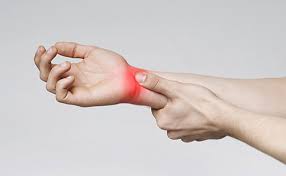Carpal tunnel syndrome (CTS)
Carpal tunnel syndrome (CTS) is a common condition that affects the wrist and hand. It is caused by compression of the median nerve, which runs through a narrow passageway in the wrist called the carpal tunnel. This compression can cause numbness, tingling, pain, and weakness in the hand and wrist.
The exact causes of CTS are not always clear, but some common risk factors include repetitive wrist motions, such as those performed during typing or assembly line work, as well as pregnancy, obesity, diabetes, and arthritis.
Treatment for CTS typically involves rest, activity modification, and the use of wrist splints to keep the wrist in a neutral position. In more severe cases, corticosteroid injections or surgery may be necessary to relieve pressure on the median nerve.
If you suspect that you may be suffering from CTS, it is important to consult a medical professional for an accurate diagnosis and appropriate treatment.
Physiotherapy management of carpel tunnel syndrome
Physiotherapy can be an effective non-surgical treatment option for individuals with carpal tunnel syndrome (CTS). The goals of physiotherapy for CTS are to reduce pain, improve wrist mobility, and restore hand and wrist function. Here are some common physiotherapy interventions used in the management of CTS:
- Manual therapy: This involves hands-on techniques such as soft tissue mobilization, joint mobilization, and stretching to improve wrist range of motion and reduce pain.
- Exercise therapy: A physiotherapist may prescribe specific exercises to strengthen the muscles around the wrist and hand, which can help to reduce pressure on the median nerve. These exercises may include wrist flexor and extensor strengthening, grip strengthening, and nerve gliding exercises.
- Modalities: Modalities such as ultrasound, electrical stimulation, and ice or heat therapy may be used to reduce pain and inflammation in the wrist and hand.
- Ergonomic advice: A physiotherapist can provide advice on ergonomic modifications to your work or home environment to help reduce strain on the wrist and prevent further damage.
- Splinting: A wrist splint may be recommended to immobilize the wrist in a neutral position, which can help to relieve pressure on the median nerve and reduce symptoms.
It is important to note that the specific physiotherapy interventions used for CTS will depend on the severity of your condition and your individual needs. A physiotherapist will work with you to develop a personalized treatment plan to help you manage your symptoms and improve your overall function.
Orthopedic treatment of carpel tunnel syndrome
Orthopedic treatment of carpal tunnel syndrome (CTS) involves a range of interventions aimed at relieving the pressure on the median nerve in the wrist. Here are some common orthopedic treatment options for CTS:
- Wrist splinting: A wrist splint is often the first line of treatment for CTS. It can help to immobilize the wrist in a neutral position, which can relieve pressure on the median nerve and reduce symptoms.
- Nonsteroidal anti-inflammatory drugs (NSAIDs): NSAIDs such as ibuprofen or naproxen can help to reduce pain and inflammation associated with CTS.
- Corticosteroid injections: Corticosteroid injections can be used to reduce inflammation and relieve pain. However, their effects are usually temporary.
- Surgery: In more severe cases, surgery may be necessary to relieve pressure on the median nerve. The procedure involves cutting the ligament that is pressing on the nerve. Surgery is usually successful in relieving symptoms and improving hand function.
- Physical therapy: Physical therapy can be helpful in managing CTS. A physical therapist can provide exercises to strengthen the muscles of the hand and wrist, stretches to improve flexibility, and modalities to reduce pain and inflammation.
It is important to note that the specific treatment plan for CTS will depend on the severity of your symptoms and your individual needs. Your orthopedic doctor will work with you to develop a personalized treatment plan to help you manage your symptoms and improve your overall function.
Chiropractic treatment for carpel tunnel syndrome
Chiropractic treatment for carpal tunnel syndrome (CTS) typically involves a combination of spinal manipulation and manual therapies focused on the wrist and hand. Here are some common chiropractic interventions used in the management of CTS:
- Spinal manipulation: Chiropractors may perform spinal adjustments to improve the mobility of the joints in the spine. These adjustments can help to reduce pressure on the nerves that supply the wrist and hand, which may alleviate CTS symptoms.
- Soft tissue therapy: Chiropractors may use a variety of soft tissue techniques, such as massage, myofascial release, and trigger point therapy, to help reduce tension in the muscles and improve circulation in the wrist and hand.
- Wrist and hand mobilization: Chiropractors may perform specific manual therapies, such as joint mobilization or stretching, to improve the mobility of the wrist and reduce pressure on the median nerve.
- Exercise therapy: Chiropractors may prescribe specific exercises to help strengthen the muscles of the hand and wrist, increase flexibility, and improve nerve gliding.
- Ergonomic advice: Chiropractors may provide advice on ergonomic modifications to your work or home environment to help reduce strain on the wrist and prevent further damage.
For all your bone and joints related problems you can contact our consultatnt orthopedic surgeon and get your problems resolved. https://kure.co.in/orthopaedics-in-noida/
Book an appointment with the best chiropractor in noida to live a pain-free life again. https://kure.co.in/chiro-chiropractor-chiropractor/
Are you sick of being in Pain? Our amazing team will get you moving PAIN FREE ! BOOK PHYSIOTHERAPY APPOINTMENT NOW https://kure.co.in/physiotherapy/
Physiotherapy and Chiropractor http://eshankaushik.com/
